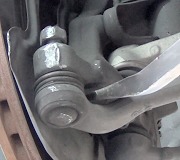Saturday, May 22nd, 2021 AT 11:15 PM
Ball joint removal problem
5 Replies
A mistake I've made more than once is there's a really wide lip on the ball joint's housing, and I had the cone on that lip instead of on the control arm. Because that lip is so large, there isn't much area for the proper-size cone to sit on. If your new joint is of the same design, use that to check that the cone fits over it and doesn't rest on that lip. That's the blue arrow I added to your dandy photo.
The next thing I've done is the stud didn't line up with the hole on the giant C-clamp, (red arrow). You may see the end of the threads are mashed over. On the car I was working on, the tool setup was different, and the C-clamp and cone were the receiver the stud had to pass into. I realized the problem when I saw the flat plate, (purple arrow), bulging up. That was from pushing the ball into the housing too far. The clues for both problems should have been I was having to tighten the C-clamp way too much. An air impact wrench can be used to make the job go faster, but if you need it to get the old ball joint to move, suspect something's wrong with the tool setup. The best luck I have is to tighten the C-clamp with a box wrench, then give the end of the pressing bolt one good smack with a fairly large hammer. The shock will break the joint loose and get it to start moving. Tighten the wrench, and give it another smack. Doing it that way takes only a little longer, and you'll work up less sweat.
The next thing I've done is the stud didn't line up with the hole on the giant C-clamp, (red arrow). You may see the end of the threads are mashed over. On the car I was working on, the tool setup was different, and the C-clamp and cone were the receiver the stud had to pass into. I realized the problem when I saw the flat plate, (purple arrow), bulging up. That was from pushing the ball into the housing too far. The clues for both problems should have been I was having to tighten the C-clamp way too much. An air impact wrench can be used to make the job go faster, but if you need it to get the old ball joint to move, suspect something's wrong with the tool setup. The best luck I have is to tighten the C-clamp with a box wrench, then give the end of the pressing bolt one good smack with a fairly large hammer. The shock will break the joint loose and get it to start moving. Tighten the wrench, and give it another smack. Doing it that way takes only a little longer, and you'll work up less sweat.
Was this helpful?
Yes
No
+1
Sunday, May 23rd, 2021 AT 5:35 PM
I was using wrong adapter that set on flange of ball joint instead of over edges. I was mushrooming it. Like first answer. Thanks was able to get out. Getting in seemed like hassel too. Was able to get ring over top but don't know if it is fully seated in groove of top of new ball joint.I used adapter with 2 3/4 OD in. To remove it. Had to rent ball joint set. Thanks
Was this helpful?
Yes
No
+1
Sunday, May 23rd, 2021 AT 6:25 PM
I knew you could do it. If there's a groove on top for a giant snap ring, and that ring drops into place, the joint is in all the way. This is the "load-carrying" joint, meaning it has the weight on that corner of the truck on it. In this design, that weight is forcing the joint into the control arm rather than trying to pull it out. That means if the joint isn't quite fully seated, the normal pounding action while driving might cause it to become fully seated over time. That won't have any effect on the alignment.
Was this helpful?
Yes
No
+1
Sunday, May 23rd, 2021 AT 7:09 PM








